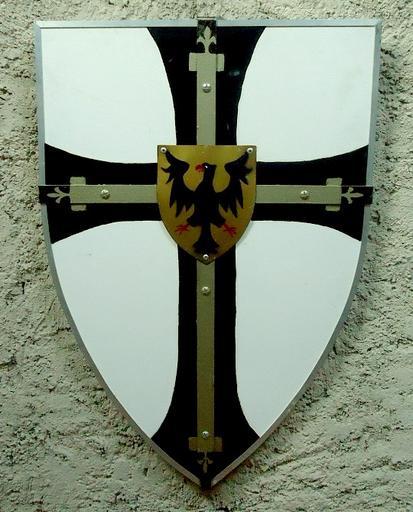MAKE A MEME
View Large Image

| View Original: | Blason_du_Grand_Maître.jpg (540x670) | |||
| Download: | Original | Medium | Small | Thumb |
| Courtesy of: | www.flickr.com | More Like This | ||
| Keywords: teutonic teutonique ritter hochmeister knight order croisade crusade ordre chevalerie blason ordo fratrum domus sanctae mariae teutonicorum ierosolimitanorum Il raconte l'histoire de l'Ordre: - la croix de sable (noire) sur champ d'argent (blanc) est l'inverse de celui des Hospitalier de Saint-Jean auquel il fut un moment attaché. - la croix d'or de Jérusalem rappelle le rôle de l'Ordre dans la défense du Royaume - les Lys d'or à ses extrémité sont une distinction octroyé par le Roy de France Louis IX (dit Saint Louis) le 20 Août 1250 lorsqu'il combattu aux côtés de l'Ordre durant la 7e Croisade - l'aigle mis en abîme (au centre) est le blason du Saint-Empire dont il se fit membre pour conquérir la Prusse "The coat of arms representing the grand master (Deutschmeisterwappen) is shown with a golden cross fleury or cross potent superimposed on the black cross, with the imperial eagle as a central inescutcheon. The golden cross fleury overlaid on the black cross becomes widely used in the 15th century. A legendary account attributes its introduction to Louis IX of France, who on 20 August 1250 granted the master of the order this cross as a variation of the Jerusalem cross, with the fleur-de-lis symbol attached to each arm. While this legendary account cannot be traced back further than the early modern period (Christoph Hartknoch, 1684) there is some evidence that the design does indeed date to the mid 13th century." Source: en.wikipedia.org/wiki/Grand_Masters_of_the_Teutonic_Order... It still exists today as religious/humanitarian association www.deutscher-orden.de/ and historical reenactment associations like www.imperialteutonicorder.com/ Il raconte l'histoire de l'Ordre: - la croix de sable (noire) sur champ d'argent (blanc) est l'inverse de celui des Hospitalier de Saint-Jean auquel il fut un moment attaché. - la croix d'or de Jérusalem rappelle le rôle de l'Ordre dans la défense du Royaume - les Lys d'or à ses extrémité sont une distinction octroyé par le Roy de France Louis IX (dit Saint Louis) le 20 Août 1250 lorsqu'il combattu aux côtés de l'Ordre durant la 7e Croisade - l'aigle mis en abîme (au centre) est le blason du Saint-Empire dont il se fit membre pour conquérir la Prusse "The coat of arms representing the grand master (Deutschmeisterwappen) is shown with a golden cross fleury or cross potent superimposed on the black cross, with the imperial eagle as a central inescutcheon. The golden cross fleury overlaid on the black cross becomes widely used in the 15th century. A legendary account attributes its introduction to Louis IX of France, who on 20 August 1250 granted the master of the order this cross as a variation of the Jerusalem cross, with the fleur-de-lis symbol attached to each arm. While this legendary account cannot be traced back further than the early modern period (Christoph Hartknoch, 1684) there is some evidence that the design does indeed date to the mid 13th century." Source: en.wikipedia.org/wiki/Grand_Masters_of_the_Teutonic_Order... It still exists today as religious/humanitarian association www.deutscher-orden.de/ and historical reenactment associations like www.imperialteutonicorder.com/ | ||||